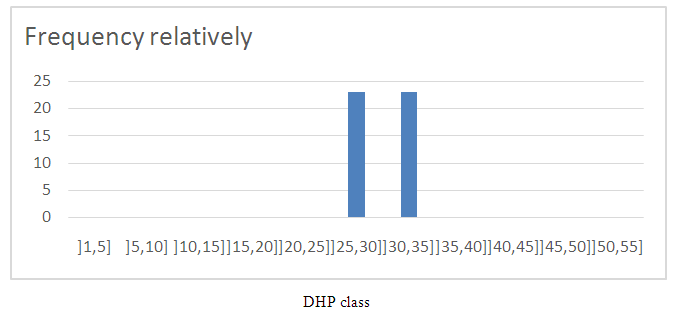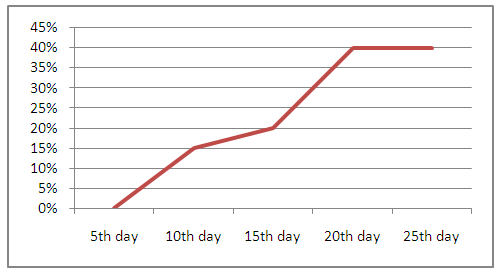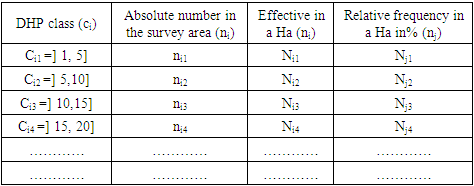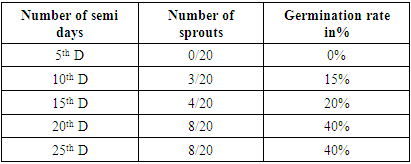-
Paper Information
- Previous Paper
- Paper Submission
-
Journal Information
- About This Journal
- Editorial Board
- Current Issue
- Archive
- Author Guidelines
- Contact Us
International Journal of Plant Research
p-ISSN: 2163-2596 e-ISSN: 2163-260X
2019; 9(2): 33-38
doi:10.5923/j.plant.20190902.03

Study of the Natural Regeneration of the Species Hernandia voyronii (Family HERNANDIACEAE) in the Kirindy Forest and Its Multiplication, District of Morondava, Menabe Region of Madagascar
Ramahaimananjato Malaza1, Landy Soambola Amelie2, Zafilaza Armand3
1University of Madagascar Antsiranana, Faculty of Sciences, Course Natural Environmental Sciences
2University of Madagascar Antsiranana, Faculty of Sciences, Course Natural Environmental Sciences, Biochemistry Option
3University of Madagascar Antsiranana, Faculty of Sciences, Course Natural Environmental Sciences, Option Marine Science
Correspondence to: Ramahaimananjato Malaza, University of Madagascar Antsiranana, Faculty of Sciences, Course Natural Environmental Sciences.
| Email: |  |
Copyright © 2019 The Author(s). Published by Scientific & Academic Publishing.
This work is licensed under the Creative Commons Attribution International License (CC BY).
http://creativecommons.org/licenses/by/4.0/

Hazomalany, Hernandiavoyroni (F.HERNANDIACEAE) is an endemic species in the western region of Madagascar. It is a special wood and the first plant of the first category. But currently it is on the list of plants threatened with extinction. The objective of this work is to study natural regeneration in Kirindy Forest and to conserve this species either by transplanting, cuttings, natural field germination or in vitro culture. In parcel number 3 (CS3) and number 5 (CS5) the regeneration is almost nil. Only in the plot number 7 (CS7) the regeneration is quite good. For the transplantation, the result is not satisfactory because of the cold season of the region Analamanga. Regarding the cuttings, the buds grow but we did not get root. Germination on natural terrain is possible with 40% success. In vitro culture gave us positive results. Seed germination 75% success in MS medium supplemented with BAP 3mg / l and 2,4-D1mg / l, microbouting gives the bud burst in MS medium supplemented with BAP 4mg / l and ANA 1mg / l and l Rooting was obtained in MS medium supplemented with BAP 0.5mg / l and ANA 1mg / l. With regard to the breeding for conservation of this species the in vitro culture is the most effective.
Keywords: Hernandia voyronii, Regeneration, in vitro, Microbouturage, Multiplication
Cite this paper: Ramahaimananjato Malaza, Landy Soambola Amelie, Zafilaza Armand, Study of the Natural Regeneration of the Species Hernandia voyronii (Family HERNANDIACEAE) in the Kirindy Forest and Its Multiplication, District of Morondava, Menabe Region of Madagascar, International Journal of Plant Research, Vol. 9 No. 2, 2019, pp. 33-38. doi: 10.5923/j.plant.20190902.03.
Article Outline
1. Introduction
- Currently Malagasy forest areas are classified as ecosystems affected by the phenomenon of degradation. This degradation is linked to the increase in the need for timber, construction, heating and coal, which leads to the impoverishment and disruption of the structure of the forest's flower population.Several governmental and non-governmental institutions such as ANGAP, DEP, CFM ... recommend programs to mitigate the degradation phenomenon aimed at keeping the remaining forest ecosystem stable.Hazomahany, Hernandia voyronii (F. Hernandiaceae), a species endemic to the dry dense forest of western Madagascar, is currently experiencing problems in its natural regeneration. Yet this tree has important technological features.Indeed, the Hazomalany was exported to India and to China where it was used for coffin manufacture. Similarly in Madagascar the Sakalava overthrow him for making the coffins of their kings [1].This species also has medicinal properties. As a result of these multiple uses, Hernandia voyronii has been ranked among the most sought-after "species" and is currently on the lists of plants threatened with extinction [2].These different reasons led us to study the regeneration of this species in a natural environment, the Kirindy Forest, as well as its multiplication.The objective of this work is the conservation of the populations of rare Hernandia voyronii species by the study of its natural regeneration, transplantation, cuttings, germination on the natural ground and on the in vitro culture.The present work thus includes the study:- Distribution of Hernandia voyronii individuals in the Kirindy Forest.- The multiplication of the species by transplantation, cuttings, germination of the seed and for a faster propagation for in vitro culture.
2. Materials and Methods
2.1. Presentation of Plant Material
- a) SystematicKingdom: PlantaeClade: SPERMATOPHYTEFamily: HERNANDIACEAESubfamily: HERNANDIOIDAEGenus: Hernandia Species: H. voyroniiHernandia voyronii is an endemic species in the western region of Madagascar. According to the determination of R. Capuron and Kubitziki, the place of Hernandia voyronii in the HERNANDIACEAE Family is justified by the following characters [2]- The leaves are single whole or lobed, palmatinised- No stipulation- Unisexual flowers- Without petals- Infected ovary uniovulate, anatropic eggNames: Vernacular: Hazomalanga, Hazomaimbo, Hazomalama, Hazomalany [2].b) Morphological descriptionThe Hazomalany, Hernandia voyronii is a large dioecious tree, cylindrical, slender and sometimes leaning. It is a tree with a strong smell reminiscent of camphor, hence its name "Hazomalany" [3].It can reach 20 to 25 m in height and its diameter from 50 to 80 cm. It is covered with a thick bark, usually beige gray in color [3].The color of the Hernandia voyronii wood is yellowish. The wood turns brown when drying. The fibers are straight, coarse-grained and have a persistent odor [3].c) Area of distributionIn Madagascar, the Hazomalany, Hernandia voyronii occurs in the dry dense forest of the western region. According to authors such as Perrier de la Bathie (12; 476) and Lavandin (9: 603), the species is thought to exist from Betsiboka to Tsiribihina in all the neighboring forest on the west coast [3].d) Field of studyThe Kirindy Forest is located in the Morondava District of Toliary Province. It is located 60 km from the road, north-east of the town of Morondava [4].The Kirindy forest is divided into several partials (fig 2), and we have all walked, only the No. 3 (CS3), the No. 5 (CS5) and the No. 7 (CS7) comprise the Hazomalany.C = conoco: old oil track; S = South; 3,5,7 = distance to Belo on Tsiribihina road in km [4].
2.2. Methods
- a) Study of the natural regeneration of Hernandia voyronii in the Kirindy ForestNatural regeneration of a species is the set of processes by which a species naturally breeds in human intervention [5]- The distribution of Hernandia voyronii individualsThe method used is that of systematic sampling. This method consists in making inventories in a surface considered homogeneous.Choice of study plotsThe study was conducted in three plots of Kirindy Forest• Parcel N° 3 (CS3)• Parcel N° 5 (CS5)• Parcel N° 7 (CS7)- Determination of the minimum sampling areaThe minimum area is the smallest area considered as a sample of the environment where the greatest number of this plant species is found [5].We chose a strip survey area or linear sampling surface (transect method) whose orientation is determined by the distribution of Hernandia voyronii species.A minimum area of 20m x 20m was used for the enumeration of individuals.We grouped individuals according to the diameter of the trunk at breast height (DBH). They were classified into 11 classes according to the following table.
|
 The regeneration rate in the 3 plots• The regeneration rate:
The regeneration rate in the 3 plots• The regeneration rate:  [6]NR: Number of regenerated individualsNS: Number of seed individualsb) Transplantation technique• Harvesting plants: Seedlings taken from the garden of the CFM (forest center of Morondava).• Field preparation: Clearing, picketing and puncturing.• Planting: each plant was depressed in the plugged hole at 3cm above collar.c) Cutting technique• Harvesting twigs.• Preparation of culture medium: 2 types of culture medium are used, substrate A (compost + black soil + sand) and B (compost + black soil without sand).• Preparation of cuttings.• Planting: Before sinking, the basal part of cuttings was soaked in takeroot powder.• Stung the cuttings in the culture medium.• Watered the cuttings grow every other day.d) Test of germination on the natural soil of Hernandia voyronii seeds• Flotation test of seeds. This technique allows to remove seeds without cotyledons.• Preparation of culture medium: Substrate: compost + black soil + sand.• Cultivation: The seeds were planted horizontally to prevent the seedlings from leaving the bottom of the seeds.f) In vitro germination test of Hernandia voyronii grains• Mechanical seed scarification: this technique facilitates seed germination.• Preparation of the culture medium in the presence of phytohormones M0 (control), M1 (BAP), M2 (BAP + GA), M3 (BAP +2.4 - D), M4 (BAP +2.4 - D), M5 (BAP + AIB).• Cultivation: Once the seeds are well dried, they are introduced gently and quickly into the culture medium.g) Microbutting [7]• Preparation of microboutures: Vegetative axis portions of seedlings resulting from seed germination in vitro.• Preparation of culture medium: The base medium is that of Murashise and Skoog (MS) + sucrose and solidified with agar-agar 8g / l.• Culturing. Each microbouture, having at least one node, was subcultured into test tubes containing culture media above.
[6]NR: Number of regenerated individualsNS: Number of seed individualsb) Transplantation technique• Harvesting plants: Seedlings taken from the garden of the CFM (forest center of Morondava).• Field preparation: Clearing, picketing and puncturing.• Planting: each plant was depressed in the plugged hole at 3cm above collar.c) Cutting technique• Harvesting twigs.• Preparation of culture medium: 2 types of culture medium are used, substrate A (compost + black soil + sand) and B (compost + black soil without sand).• Preparation of cuttings.• Planting: Before sinking, the basal part of cuttings was soaked in takeroot powder.• Stung the cuttings in the culture medium.• Watered the cuttings grow every other day.d) Test of germination on the natural soil of Hernandia voyronii seeds• Flotation test of seeds. This technique allows to remove seeds without cotyledons.• Preparation of culture medium: Substrate: compost + black soil + sand.• Cultivation: The seeds were planted horizontally to prevent the seedlings from leaving the bottom of the seeds.f) In vitro germination test of Hernandia voyronii grains• Mechanical seed scarification: this technique facilitates seed germination.• Preparation of the culture medium in the presence of phytohormones M0 (control), M1 (BAP), M2 (BAP + GA), M3 (BAP +2.4 - D), M4 (BAP +2.4 - D), M5 (BAP + AIB).• Cultivation: Once the seeds are well dried, they are introduced gently and quickly into the culture medium.g) Microbutting [7]• Preparation of microboutures: Vegetative axis portions of seedlings resulting from seed germination in vitro.• Preparation of culture medium: The base medium is that of Murashise and Skoog (MS) + sucrose and solidified with agar-agar 8g / l.• Culturing. Each microbouture, having at least one node, was subcultured into test tubes containing culture media above.3. Results and Interpretation
3.1. Natural Regeneration of Hernandia voyronii in Kirindy Forest
- - Parcel N° 3 (CS3)
 | Figure 1. The histogram showing the distribution of Hernandia voyronii individuals in plot 3 (CS3) |
 | Figure 2. The histogram showing the distribution of Hernandia voyronii individuals in plot 5 (CS5) |
 | Figure 3. The histogram showing the distribution of Hernandia voyronii individuals in plot No. 7 (CS7) |
3.2. The Multiplication
- a) Transplantation [8]Seedlings from seeds from the Morondava Forest Center (CFM) garden, six months old and 30 cm tall, transplanted into the garden of CNARP Antananarivo at least in February 2004.During the year 2004 buds bud and leaves were formed until the cold season of 2005. The plant grows normally, but after the second cold season, August 2005, the plant perished. This transplantation experiment shows the sensitivity of the Hernandia voyronii species to cold weather.b) Cuttings [8]Two types of culture media are used. Substrate container A (Compost + black soil + white sand) and B (compost + black soil without sand).Based on the result, there is a significant difference between the burst rate obtained from two types of substrates A and B (68% and 38%). For the substrate A, because of its composition in sand, it will constitute a highly draining medium which ensures a good aeration, favoring thereafter conditions of bud bursting. In addition, the presence of hormone Takeroot favors the burning of buds. Bud buds develop and give leaves. They grow, but their growth is slow. But during the cold season (August 2005) a fall of the leaves was observed and all the cuttings perished.c) Germination on the natural soil [9] (20 seeds are used)According to the result the maximum rate of germination is only 40%. Seed germination occurs between the 10th and 20th day of the crop.
 | Figure 4. Curve showing germination rate on natural soil |
|
|
 | Figure 5. Curve showing germination of non-scarified seeds in M3 medium |
3.3. The Growth Pattern of Hermandia Voyronii Seedlings in the M3 Medium as a Function of Time
- Seedlings grow rapidly. After 30 days their average lengths can reach up to 5 cm and a taproot is observed. After the formation of the root, the aerial part begins to grow, three small leaves and three nodes have appeared of young plant reached up to 6.5 cm and the seedlings are ready for microbouturing.
|
4. Discussion
- The results show that regeneration of Hernandia voyronii in Kirindy Forest is weak, only a few plots contain the species. In plot no. 3 and no. 5 the species exists but seedlings and young seedlings are absent ie regeneration is nil. These plots are located in the sparse forest area and close to residential areas and near the road. While in plot No. 7, located in the heart of the forest, the species exists and the regeneration is good.The weakness of the regeneration could be explained by several causes: intensive exploitation, the forest become sparse, indeed the seedlings are directly exposed to the light. However, according to Randrianasolo, Hernandia voyronii is strictly a sciaphyll (shade plant) at least in its infancy until it reaches a height of 5 to 8 m. Moreover, because of their scent, the seeds that fall are attacked quickly by predators that are mainly insects. It is for these reasons that the regeneration of Hernandia voyronii in the Kirindy Forest is weak.With regard to transplantation, all seedlings planted in winter die right away. An older two-meter-tall plant remains in a winter season (winter 2004), but in the following winter (winter 2005) it dies at the end of August. So this species can not stand cold.For vegetative propagation by cuttings, bud burst was positive but rooting was not effective. Bud burst was favored by the use of sand in the substrate. The rooting did not take place, perhaps because the cuttings were carried out in the garden of the CNARP (National Center for Pharmaceutical Research) during the winter period.For sexual propagation by scarified seed, in vitro germination started at the 5th day of culture and the maximum germination rate was 87.5%, whereas in vitro non-scarified germination required 10 days with a maximum rate 40% although the float test was positive. This difference could be due to the scarification suffered by the seed as well as the quality and duration of seed storage.With regard to vegetative propagation by microbouting, bud burst and rooting were positive in the medium containing BAP and ANA. The results are in agreement with Marashige and Skoog's recommendation [11,12]. But compared to other species these proportions are large and produce an inhibitory effect on the metabolic activity of the plant cell [13,14].
5. Conclusions
- Hazomalany, Hernandia voyronii is an endemic species from western Madagascar that is overexploited because of the undeniable quality of its wood and its ease to be worked. We come to a sad conclusion about the natural regeneration of this species. Only a few parcels contain the species. In the 3 plots that we have chosen, the plot N° 7 has a fairly good regeneration.Concerning the multiplication, the experiments are positive but the conditions of the cold season of the high ground is the cause of the mortality of the young plants.To mitigate the deficiency of regeneration and for the conservation of the Hernandia voyronii species, consideration should be given to:- The reintroduction of this plant in its natural environment.- Better control of holdings to prevent illegal logging.- Store stands rich in Hernandia voyronii over the extent of its natural range.- Update the texts concerning the Hernandia voyronii and if necessary create the specific texts.- Better to sow the seed as soon as possible after harvest if no means of conservation has been.
 Abstract
Abstract Reference
Reference Full-Text PDF
Full-Text PDF Full-text HTML
Full-text HTML


